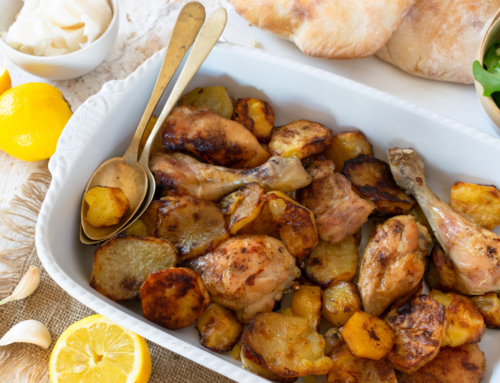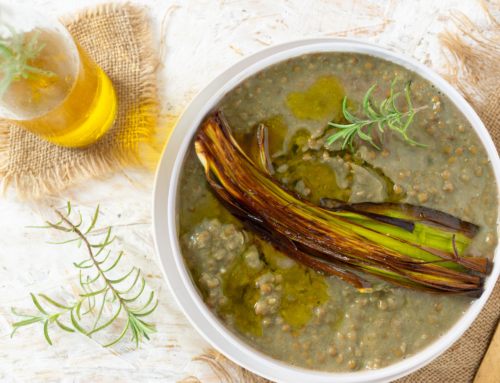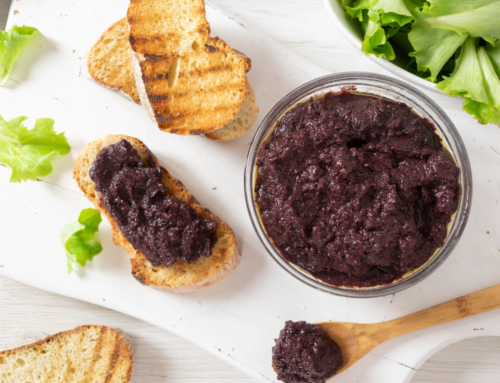Puttanesca is the name of a very basic sugo (sauce), featured in this risotto puttanesca recipe, that is well-known in Naples and all of southern Italy. Apparently, a similar recipe or sauce has been made with the same ingredients since the 18th century, during the Borbone reign in Naples. But the name comes from a story that happened during the 1950s on the island of Ischia.
Here, in a famous restaurant on the island, the owner, Sandro Petti, was inventing a dish to serve some late-arriving customers. The kitchen was closed and he was running out of ingredients, but Sandro was able to make a delicious meal with only a few tomatoes, capers, and black olives. The name puttanesca comes from the expression Puttanata, which apparently those guests said to Sandro: “facci una qualsiasi puttanata.” Literally, this means (in a very vulgar manner): “make any rubbish to eat.”
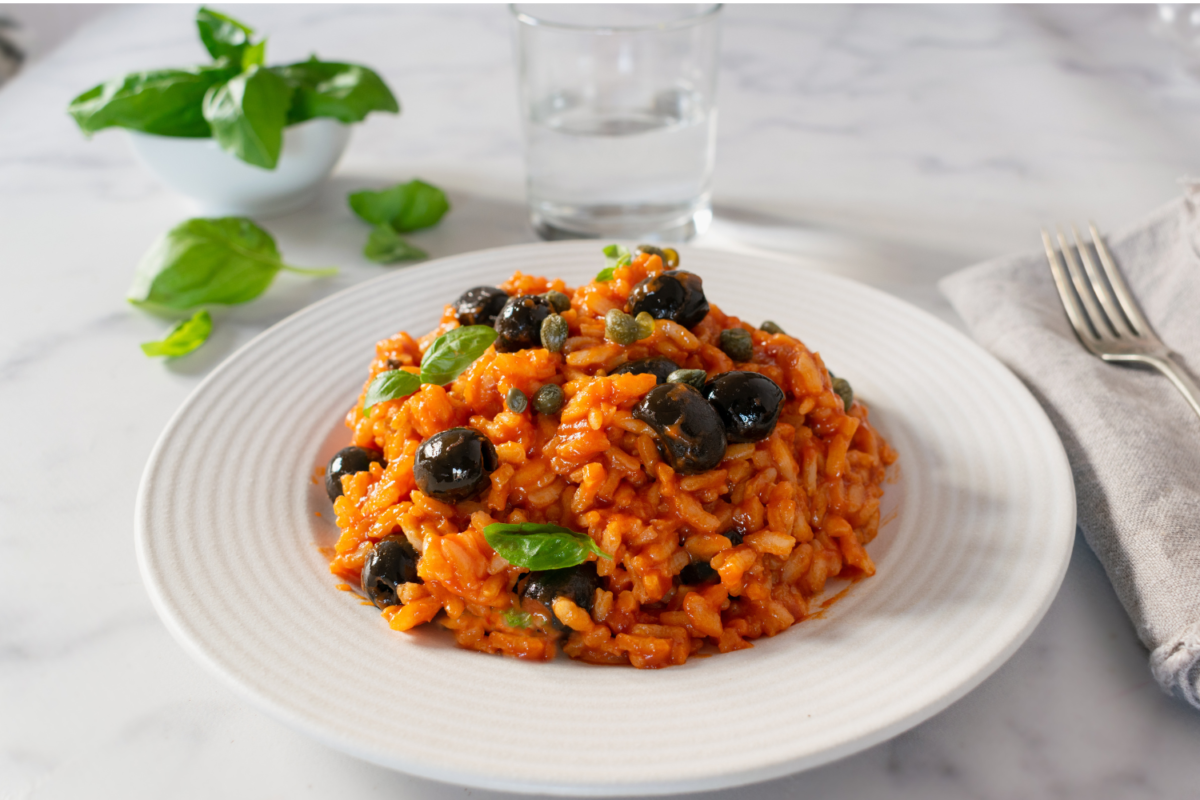
Though the name might be controversial, the dish is absolutely one of the easiest pasta dishes you can make with pantry staples and probably one of the most balanced. You see, there’s acidity from the tomatoes, bitterness from olives, saltiness from anchovies, and sweetness from raisins.
There are hundreds of versions of this traditional puttanesca sauce recipe, such as: with or without anchovies, with fresh tomatoes or canned pomodori pelati tomatoes, and with or without raisins.
The best part is, we can make this puttanesca recipe a valid component not just for pasta, but for pizza or risotto as well. I propose my easy risotto puttanesca recipe. It includes broth made from tomato sauce diluted with vegetable stock, anchovies melted completely at the beginning, and toasted rice.
Another chapter can be written about the herbs used in a traditional puttanesca recipe. Officially, I believe that the most used herb for the dish is fresh parsley, which fits perfectly. But I will invite you to use basil instead, since I think it is always the best herb with tomato puttanesca sauce.
Notes
- Want to bring the heat? Puttanesca sauce is often made with an additional pinch of crushed red pepper flakes, so go right ahead and add that if you like. Another option is one chopped red chili.
- As mentioned, I am on team fresh basil here. But please feel free to substitute it for chopped fresh parsley instead. You can also add a tablespoon of chopped fresh oregano when you add the chopped basil in the beginning for that quintessential Italian flavor.
- Passata di pomodoro is tomato passata. But you can also use tomato puree, 5 to 6 fresh tomatoes (that you puree yourself using a blend or food processor), or a can of diced tomatoes or whole peeled San Marzano tomatoes (also pureed).
- To make the risotto, I’m using medium-grain rice. But feel free to use arborio rice instead.
- If you like, add one chopped onion (either a yellow onion or red onion). Saute it after the anchovies and before adding the rice.
FAQs
What is puttanesca sauce?
Most commonly served over pasta, puttanesca sauce is a tomato-based pasta sauce traditionally made with a combination of anchovies, olives, garlic, and capers.
What does puttanesca sauce taste like?
The flavorful profile of puttanesca sauce is unparalleled. It’s the perfect combination of sweet and salty, thanks to tomatoes and oil combined with olives, capers, and anchovies.
What can I use instead of anchovies in pasta alla puttanesca?
The vegan alternative to anchovies is dried seaweed (nori). Otherwise, you can leave it out or substitute it for one tablespoon of anchovy paste. But I definitely recommend giving it a go, as the fillets melt into the dish and just add a delicious umami flavor.
Is puttanesca sauce vegan?
No, this particular puttanesca sauce recipe isn’t vegan as it includes anchovy fillets. But do the swap above or simply omit them from the recipe and you instantly have vegan puttanesca risotto.
What can I substitute for capers?
Instead of capers you can simply add another tablespoon of black olives or change it up and opt for green olives instead.
What wine goes well with puttanesca?
Puttanesca pairs well with acidic and earthy red wines like pinot noir, Chianti Classico, and Primitivo.
How do you make puttanesca pasta?
We actually have a puttanesca pasta recipe on Mediterranean Living, so click here for that blog post. This particular pasta puttanesca recipe has a similar sauce, but it’s paired with spaghetti and canned tuna.
Can you put meat in a puttanesca recipe?
Absolutely! If you’re not concerned with this meal being vegetarian/vegan, you have two main options:
- Stir in some leftover cooked and shredded chicken breast.
- Add a drained can of tuna.
Just let them simmer in the sauce for a couple of minutes before serving.
What do you eat with puttanesca?
This is the perfect Italian comfort food main dish as is. But here are some serving options:
- Freshly grated pecorino romano or parmesan cheese.
- A lemon wedge
- Garlic bread
- A bean salad or tuna and bean salad.
- Arugula salad
- Traditional grilled Italian vegetables
How long does puttanesca last in the fridge?
You can store leftover puttanesca in an airtight container in the fridge for up to four days. Reheat it over medium heat on the stovetop. You may need to add a drop of water if the sauce looks a little dry. This isn’t cause for concern, it happens!
Can this recipe for puttanesca be frozen?
Yes, you can freeze this risotto puttanesca in a freezer-safe container for up to three months. Thaw it in the fridge overnight before reheating it as above.
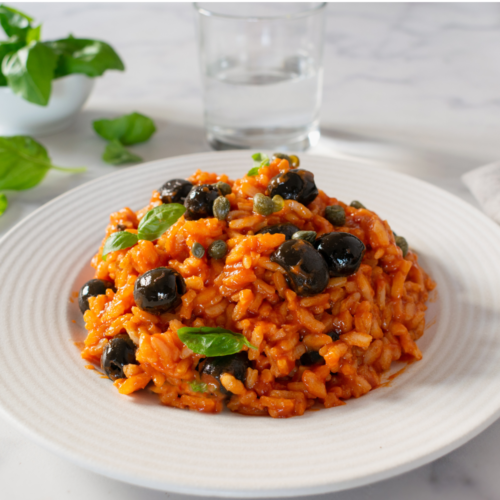
Rice with Puttanesca Sauce (Risotto alla Puttanesca)
Ingredients
- 20 ounces Passata di pomodoro (or tomato puree)
- 2 cups Vegetable stock
- 6 to 8 Fresh basil leaves, divided
- 2 tsp Kosher salt
- 1 tsp Freshly ground black pepper
- 4 tbsp Extra virgin olive oil
- 2 cloves Garlic, crushed
- 4 Anchovy fillets in oil
- ⅔ cup Medium-grain rice (Carnaroli or Vialone Nano)
- ½ cup Dry white wine
- 2 tbsp Unsalted butter
- 1 tbsp Capers in salt, washed to remove salt
- 4 tbsp Pitted black olives (like Kalamata olives), chopped
Instructions
- Dilute the tomato sauce with the stock in a large pot and put it over low heat. Add half of the basil leaves, pepper, and salt, and keep the mixture warm (don’t let it boil).
- Drizzle the olive oil in a large pan. Add the garlic and anchovies and, over very low heat, melt the anchovies completely in the oil. This takes about 2 minutes. I move the pan back and forth from the heat to avoid burning the garlic.
- Once the anchovies are melted, remove the garlic, and add the rice. Toast the rice in the oil for about 2 minutes, until it is hot to the touch. Add the wine to deglaze the pan, stirring until the wine has evaporated and absorbed. Start pouring the diluted tomato sauce into the pan a little at a time. Make sure to stir the rice frequently and always wait for the liquid to evaporate almost completely before adding more.
- After 30 to 35 minutes of stirring occasionally, the rice should be soft. Add the butter, capers, and olives, and turn off the heat. Stir the mixture vigorously to melt the butter with the residual heat. This gives the risotto a creamy consistency. Cover the pan and let the risotto rest for 5 minutes.
- Serve the risotto with the remaining basil on top.


